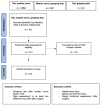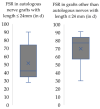The Grasping Test Revisited: A Systematic Review of Functional Recovery in Rat Models of Median Nerve Injury
- PMID: 36009423
- PMCID: PMC9405835
- DOI: 10.3390/biomedicines10081878
The Grasping Test Revisited: A Systematic Review of Functional Recovery in Rat Models of Median Nerve Injury
Abstract
The rat median nerve model is a well-established and frequently used model for peripheral nerve injury and repair. The grasping test is the gold-standard to evaluate functional recovery in this model. However, no comprehensive review exists to summarize the course of functional recovery in regard to the lesion type. According to PRISMA-guidelines, research was performed, including the databases PubMed and Web of Science. Groups were: (1) crush injury, (2) transection with end-to-end or with (3) end-to-side coaptation and (4) isogenic or acellular allogenic grafting. Total and respective number, as well as rat strain, type of nerve defect, length of isogenic or acellular allogenic allografts, time at first signs of motor recovery (FSR) and maximal recovery grasping strength (MRGS), were evaluated. In total, 47 articles met the inclusion criteria. Group I showed earliest signs of motor recovery. Slow recovery was observable in group III and in graft length above 25 mm. Isografts recovered faster compared to other grafts. The onset and course of recovery is heavily dependent from the type of nerve injury. The grasping test should be used complementary in addition to other volitional and non-volitional tests. Repetitive examinations should be planned carefully to optimize assessment of valid and reliable data.
Keywords: allograft; animal; autograft; functional recovery; grasping test; median nerve; nerve crush; nerve repair; nerve transection; rat.
Conflict of interest statement
The authors declare no conflict of interest.
Figures






Similar articles
-
Evaluation of Functional Recovery in Rats After Median Nerve Resection and Autograft Repair Using Computerized Gait Analysis.Front Neurosci. 2021 Jan 21;14:593545. doi: 10.3389/fnins.2020.593545. eCollection 2020. Front Neurosci. 2021. PMID: 33551723 Free PMC article.
-
A meta-analysis of functional outcomes in rat sciatic nerve injury models.Microsurgery. 2021 Mar;41(3):286-295. doi: 10.1002/micr.30713. Epub 2021 Jan 28. Microsurgery. 2021. PMID: 33511636 Review.
-
Reflex-based grasping, skilled forelimb reaching, and electrodiagnostic evaluation for comprehensive analysis of functional recovery-The 7-mm rat median nerve gap repair model revisited.Brain Behav. 2017 Sep 6;7(10):e00813. doi: 10.1002/brb3.813. eCollection 2017 Oct. Brain Behav. 2017. PMID: 29075572 Free PMC article.
-
Contralateral C7 transfer combined with acellular nerve allografts seeded with differentiated adipose stem cells for repairing upper brachial plexus injury in rats.Neural Regen Res. 2019 Nov;14(11):1932-1940. doi: 10.4103/1673-5374.259626. Neural Regen Res. 2019. PMID: 31290451 Free PMC article.
-
Efficacy evaluation of personalized coaptation in neurotization for motor deficit after peripheral nerve injury: A systematic review and meta-analysis.Brain Behav. 2020 Apr;10(4):e01582. doi: 10.1002/brb3.1582. Epub 2020 Mar 3. Brain Behav. 2020. PMID: 32129004 Free PMC article.
Cited by
-
Improving nerve and muscle function: an exploration of targeted nerve function replacement following differential delay periods in a rat model.J Neuroeng Rehabil. 2025 Jul 4;22(1):145. doi: 10.1186/s12984-025-01666-0. J Neuroeng Rehabil. 2025. PMID: 40615906 Free PMC article.
-
End-to-side neurorrhaphy in the reconstruction of peripheral segmental neural loss: an experimental study.Acta Cir Bras. 2024 Jul 22;39:e394024. doi: 10.1590/acb394024. eCollection 2024. Acta Cir Bras. 2024. PMID: 39046042 Free PMC article.
References
Publication types
LinkOut - more resources
Full Text Sources
Miscellaneous

